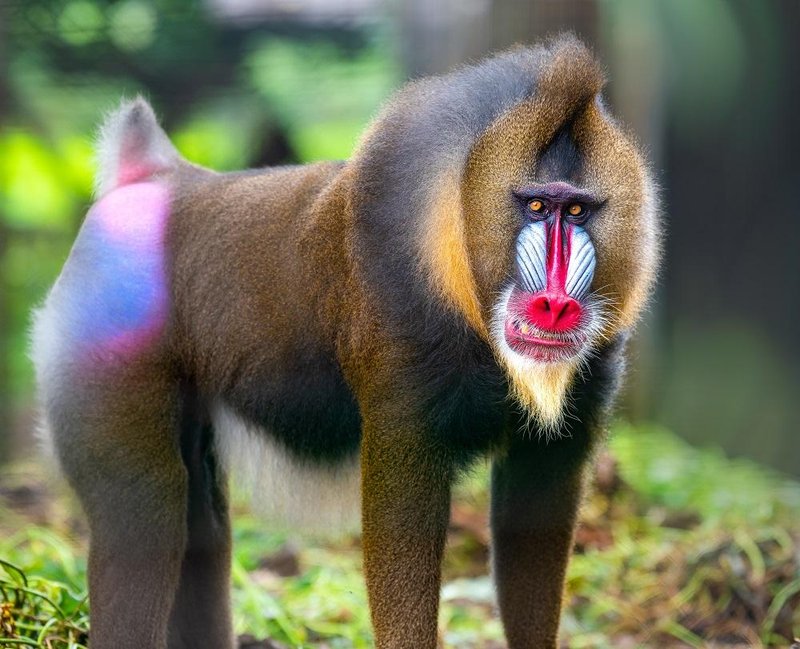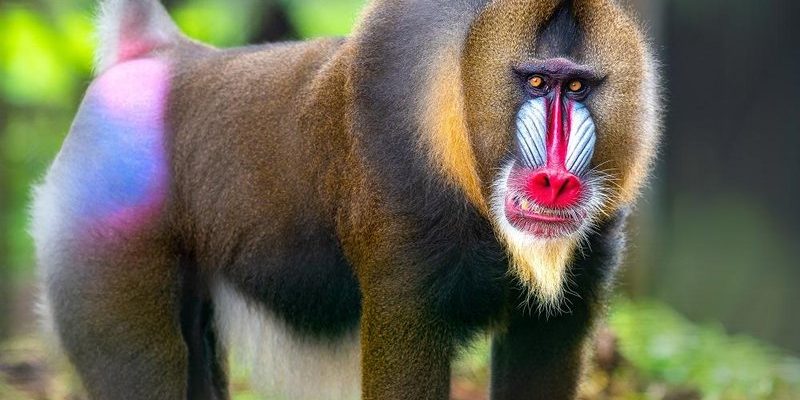
Now, imagine you’re sitting with a friend over coffee, and they ask you about other animals that look like the mandrill. You might find yourself diving into a lively discussion about not only the mandrill’s unique features but also how to recognize other similar animals. So, let’s talk about ten animals that share some characteristics with the mandrill, and, more importantly, how to tell them apart.
1. Baboons
Baboons are perhaps the most recognizable relatives of the mandrill. Both belong to the same family, Cercopithecidae, and share a lot in terms of social structure and behavior. They are large, ground-dwelling primates known for their loud vocalizations and tight-knit hierarchies.
If you’re trying to tell baboons apart from mandrills, focus on their facial features. Baboons have a longer, more dog-like muzzle, while mandrills sport a flatter face with bright blue and red coloring. Also, baboons tend to have a more uniform fur color, whereas mandrills are famous for their vivid hues, particularly in the males.
2. Geladas
Next up, let’s talk about geladas. While they might not be as colorful as mandrills, geladas share several similarities, especially their social behaviors. Found mainly in Ethiopia, these unique primates are known for their complex social structures, just like mandrills.
You might notice that geladas have a distinct mane of hair that resembles a lion’s, differentiating them from mandrills. Their facial structure is also different, with geladas having a more pronounced jawline and a less colorful face. They’re primarily herbivorous, feeding mainly on grass, which sets them apart from more omnivorous mandrills.
3. Proboscis Monkeys
Proboscis monkeys are known for their impressive, long noses that hang down, which can be quite a sight to see! These monkeys share the same tropical forest habitat as mandrills, primarily found in Borneo and Sumatra.
When comparing them to mandrills, you can’t miss that elongated nose. While both species have a social yet playful demeanor, mandrills have a more vibrant face with distinct blue and red markings. If you’re ever unsure, just look for that nose—it’s a big giveaway!
4. Macaques
Macaques come in various species, some of which can resemble mandrills. They are highly adaptable and found in numerous countries across Asia and Africa. Their social behaviors, like living in troops and displaying playful interactions, mirror those of mandrills.
However, macaques generally have a more subdued color palette. Their fur can range from grey to brown, and their facial features are less marked compared to the flamboyant mandrill. Keep an eye on their tail, too; macaques often have longer, more expressive tails than their mandrill cousins.
5. Squirrel Monkeys
Squirrel monkeys are smaller and more delicate than mandrills, but they share that playful spirit we see in many primates. These little guys are mostly found in Central and South America and love to leap around the treetops.
What sets them apart is their size and coloring. While mandrills are known for their bulky build and vivid colors, squirrel monkeys generally have a lighter hue and a more petite frame. So, if you see a small, active monkey with a yellow belly and darker back, you’re likely looking at a squirrel monkey—not a mandrill.
6. Howler Monkeys
When it comes to vocalizations, howler monkeys take the crown! Their loud calls can be heard from miles away, making them quite the noisy neighbors. While they are not as colorful as mandrills, they do share a similar body shape and social traits.
To distinguish howler monkeys from mandrills, check out their vocal apparatus. Howler monkeys have a unique throat structure that amplifies their calls, and they typically have less vibrant facial coloring. Mandrills, on the other hand, flaunt their bright facial colors and larger size.
7. Tamarin Monkeys
Tamarins are small, agile primates that stand out with their tufted hair and lively personalities. While their size sets them apart from the larger mandrills, they do share some similar social dynamics and group living habits.
Overall, tamarins are much smaller and have more distinct fur patterns. They often have unique facial markings and a playful demeanor, though they lack the vivid coloration seen in mandrills. If you see a tiny monkey with fluffy ears and a curious expression, it’s likely a tamarin.
8. Capuchin Monkeys
Capuchin monkeys are famous for their intelligence and ability to use tools. Found primarily in Central and South America, they have similar social behaviors to mandrills, forming tight family groups.
To differentiate them, look for their coloration and size. Capuchins have a more muted color scheme, often with a cream or light brown body and a darker face and limbs. Plus, they generally have a smaller stature compared to the hefty mandrill. Their expressive faces and agile movements can make them a delightful sight, though they lack the striking features of a mandrill.
9. Spider Monkeys
Spider monkeys are known for their long limbs and prehensile tails, making them superb gymnasts in the trees. They are also highly social and often form large groups, similar to mandrills.
However, spider monkeys are much leaner and have a different body shape. Their fur can be brown or black, and their facial features are less colorful than those of mandrills. If you spot a monkey swinging effortlessly through the trees with a long tail, you’re likely looking at a spider monkey.
10. Chimpanzees
Finally, we have chimpanzees—our closest relatives in the animal kingdom. They share a lot of behavioral traits with mandrills, including social structures and communication methods.
Yet, chimps have a distinct appearance; they are generally more robust with dark fur and a flatter face. They lack the vibrant color and characteristic features of the mandrill. If you see a large primate with a friendly demeanor and dark fur, it’s probably a chimpanzee.
In summary, the animal kingdom is full of fascinating creatures that share traits with the mandrill. From the playful behaviors to social structures, many animals exhibit similar characteristics. Knowing how to tell them apart just adds to the wonder of their diversity. Next time you see a colorful mandrill, you can appreciate it even more by recognizing its closest relatives!

